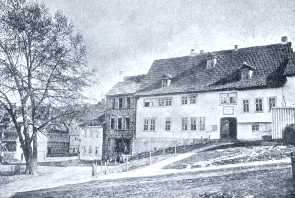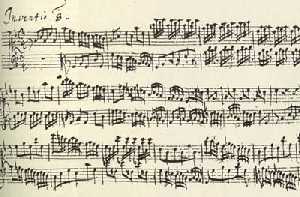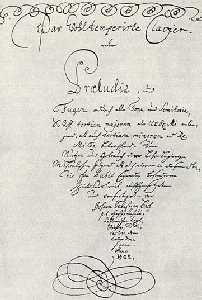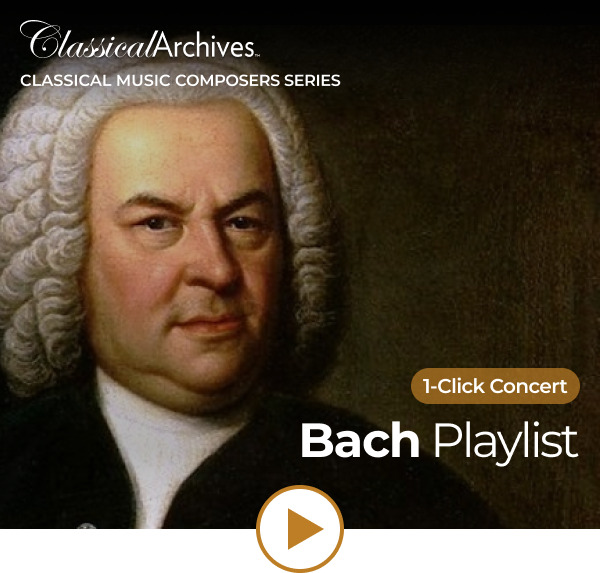 About Johann Sebastian Bach
About Johann Sebastian Bach
It has been observed that Bach's melodies are harmonically conceived and his harmonies melodically conceived. This is a pithy way of saying that the music of Johann Sebastian Bach is the culmination of not only the Baroque era, but the Renaissance as well. The Baroque era began as a reaction against the highly refined and intellectual Flemish contrapuntal style that is the essence of the high Renaissance. Early Baroque opera led to our modern concept  of harmony by declaring the primacy of a single melodic line supported by chords designated by a figured bass. The concept of melody with harmonic accompaniment was the beginning of thinking about harmony and harmonic progressions as an important entity and not just the by-product of intersecting lines. Two hundred and fifty years later, Schumann, great student of Bach that he was, would declare that in the chess game of music melody is the queen but the game depends on harmony, the king.
of harmony by declaring the primacy of a single melodic line supported by chords designated by a figured bass. The concept of melody with harmonic accompaniment was the beginning of thinking about harmony and harmonic progressions as an important entity and not just the by-product of intersecting lines. Two hundred and fifty years later, Schumann, great student of Bach that he was, would declare that in the chess game of music melody is the queen but the game depends on harmony, the king.
Bach's music reconciles these two aspects; the horizontal (melodic) and the vertical (harmonic) in complete balance. While his music often has the linear complexity of Renaissance polyphony, it also has a sure and inevitable harmonic architecture that always gives the music a sense of solid form and direction. For instance, in the great Preludium of the Partita for Solo Violin, the constant stream of sixteenth notes reach important arrival and departure points on E, c#, A, f#, B, and back to E. The descending thirds give us a large structural I, ii, V, I cadential progression that girds the entire piece.
Bach's music also synthesizes the prevailing French and Italian styles that dominated the Baroque era. The Italian style, with its emphasis on operatic singing and string playing, tends to be more rhythmically straight forward, emotionally extroverted, and prone to the use of repeating harmonic sequences. French music, on the other hand, grows out of a love for wind instruments and dancing, and the emotional quality is often subtle and less overt. One need look no further than any of the Bach keyboard suites - the so-called French Suites (such as the French Suite No.4 in Eb, BMV.815), English Suites (for example, the English Suite No.3 in G: 1.Prélude; 2.Allemande; 3.Courante; 4.Sarabande; 5.Gavottes I and II; 6.Gigue), and the Partitas (No.1 in Bb; No.2 in C; No.3 in A; No.4 in D; No.5 in g; and the No.6 in E) to see the comfortable juxtaposition of a French Allemande with an Italian Corrente, followed by a French Saraband overlaid with flamboyant, Italian operatic ornamentation.
Bach's cosmopolitan style belies the fact that he travelled so little, although in his youth he did famously walk 200 miles to hear Buxtehude play the organ. Unlike Handel, who studied in Italy, Bach absorbed much of his Italian influence by copying out large amounts of Vivaldi.  From Froberger, a German harpsichordist who lived in France, he assimilated the French keyboard style. The latter was in turn influenced by the "broken style" of the French lutenists who found a way to suggest more than one part within a single line. This is an important feature of Bach's melodic style and even the single subject of a fugue will contain contrapuntal elements within it. This ability is also what allowed Bach to write his solo violin and cello sonatas, partitas and suites where a single voiced instrument weaves a tapestry of contrapuntal implications.
From Froberger, a German harpsichordist who lived in France, he assimilated the French keyboard style. The latter was in turn influenced by the "broken style" of the French lutenists who found a way to suggest more than one part within a single line. This is an important feature of Bach's melodic style and even the single subject of a fugue will contain contrapuntal elements within it. This ability is also what allowed Bach to write his solo violin and cello sonatas, partitas and suites where a single voiced instrument weaves a tapestry of contrapuntal implications.
Most of Bach's working life was spent as a Kapellmeister of various important churches, where he was responsible for the music performed at weekly Sunday services, in addition to such onerous activities as teaching Latin (which he regularly complained about). In his own life Bach was known more as a virtuoso organist and improviser and he was considered learned but eccentrically old fashioned as a composer what with his obsessions with arcania such as fugue and ricercar. His sons (J.C., W.F. and C.P.E. Bach) were much more up to date. It should be mentioned that in addition to his large and uniformly high level musical output, he had twenty children by two wives.
Bach's devout Lutheran faith pervades all his works, be they instrumental or vocal, and one cannot fully understand him without knowing many of the over two hundred sacred cantatas he wrote for Sunday services (such as Christ Lag in Todesbanden; Mer hahn en neue Oberkeet; and Jesu, Joy of Man's Desiring from "Herz Und Mund Und Tat Und Leben"), or the great masses and passions, such as the Mass in b (excerpts include 1.Kyrie eleison; 11.Cum sancto spiritu; 23.Dona nobis pacem) and the St. Matthew Passion (excerpts include Herzliebster Jesu; Erbarm' dich Mein Gott, and O Haupt voll Blut und Wunden), written for Easter and other high holy days. Here one can discover the elaborate use of musical figures employed to express text, which also pervade the purely instrumental music.
 Throughout his life, Bach seemed to be driven to systematically explore all the possibilities of a given style or genre. In his organized and numerologically based way there are six Brandenburg Concerti - the essence of the Italian style as opposed to the four Orchestral Suites, (including the Allegro from the Brandeburg Concerto No.1; the Adagio from No.2, and the Allegro from No.5), six of each of the keyboard suites mentioned above, six cello suites, six solo violin works, etc. Each of the pieces in these collections explores or emphasizes another possibility within the type. A veritable bible for musicians, the two books of The Well-Tempered Klavier (includes the Prelude and Fugue No.1 in C and Prelude and Fugue No.17 in Ab from Book 1, and the Prelude and Fugue No.13 in F# from Book 2) twice present preludes and fugues of every imaginable type in every key. The miracle of these pieces is that the overwhelming intellectual mastery is always in the service of an even higher emotional character and spirit, explored with unending variety. At the end of his life Bach was still exploring the ultimate possibilities of counterpoint in The Art of the Fugue (contains Contrapunctus 12 rectus and Contrapunctus 12 inversus) and The Musical Offering.
Throughout his life, Bach seemed to be driven to systematically explore all the possibilities of a given style or genre. In his organized and numerologically based way there are six Brandenburg Concerti - the essence of the Italian style as opposed to the four Orchestral Suites, (including the Allegro from the Brandeburg Concerto No.1; the Adagio from No.2, and the Allegro from No.5), six of each of the keyboard suites mentioned above, six cello suites, six solo violin works, etc. Each of the pieces in these collections explores or emphasizes another possibility within the type. A veritable bible for musicians, the two books of The Well-Tempered Klavier (includes the Prelude and Fugue No.1 in C and Prelude and Fugue No.17 in Ab from Book 1, and the Prelude and Fugue No.13 in F# from Book 2) twice present preludes and fugues of every imaginable type in every key. The miracle of these pieces is that the overwhelming intellectual mastery is always in the service of an even higher emotional character and spirit, explored with unending variety. At the end of his life Bach was still exploring the ultimate possibilities of counterpoint in The Art of the Fugue (contains Contrapunctus 12 rectus and Contrapunctus 12 inversus) and The Musical Offering.
Bach left supreme works in every genre of his age except opera. Ironically this great conservative who really did nothing new, but only better and more completely, is for many musicians the true beginning of modern music. In many works (e.g. the chromatic variations of the Goldberg Variations) we can see the harmonic possibilities of the future. Bach's materials are often made from the most basic stuff of music-scales and arpeggios-and this perhaps partly explains the health and solidity of his music. For musicians, it is the universal folk music in which we bathe to purify our souls.
Biography by Allen Krantz. Copyright © Classical Archives, LLC. All rights reserved.

 of harmony by declaring the primacy of a single melodic line supported by chords designated by a figured bass. The concept of melody with harmonic accompaniment was the beginning of thinking about harmony and harmonic progressions as an important entity and not just the by-product of intersecting lines. Two hundred and fifty years later, Schumann, great student of Bach that he was, would declare that in the chess game of music melody is the queen but the game depends on harmony, the king.
of harmony by declaring the primacy of a single melodic line supported by chords designated by a figured bass. The concept of melody with harmonic accompaniment was the beginning of thinking about harmony and harmonic progressions as an important entity and not just the by-product of intersecting lines. Two hundred and fifty years later, Schumann, great student of Bach that he was, would declare that in the chess game of music melody is the queen but the game depends on harmony, the king. From Froberger, a German harpsichordist who lived in France, he assimilated the French keyboard style. The latter was in turn influenced by the "broken style" of the French lutenists who found a way to suggest more than one part within a single line. This is an important feature of Bach's melodic style and even the single subject of a fugue will contain contrapuntal elements within it. This ability is also what allowed Bach to write his solo violin and cello sonatas, partitas and suites where a single voiced instrument weaves a tapestry of contrapuntal implications.
From Froberger, a German harpsichordist who lived in France, he assimilated the French keyboard style. The latter was in turn influenced by the "broken style" of the French lutenists who found a way to suggest more than one part within a single line. This is an important feature of Bach's melodic style and even the single subject of a fugue will contain contrapuntal elements within it. This ability is also what allowed Bach to write his solo violin and cello sonatas, partitas and suites where a single voiced instrument weaves a tapestry of contrapuntal implications. Throughout his life, Bach seemed to be driven to systematically explore all the possibilities of a given style or genre. In his organized and numerologically based way there are six Brandenburg Concerti - the essence of the Italian style as opposed to the four Orchestral Suites, (including the Allegro from the
Throughout his life, Bach seemed to be driven to systematically explore all the possibilities of a given style or genre. In his organized and numerologically based way there are six Brandenburg Concerti - the essence of the Italian style as opposed to the four Orchestral Suites, (including the Allegro from the 





